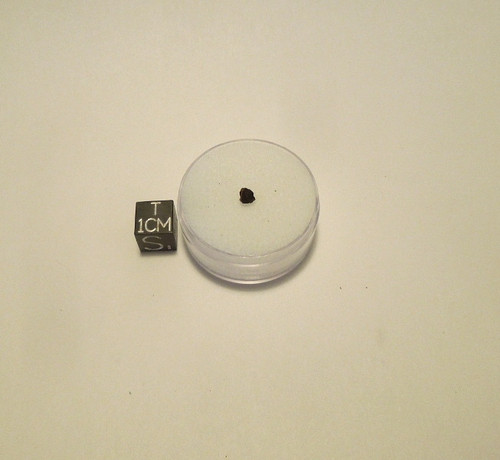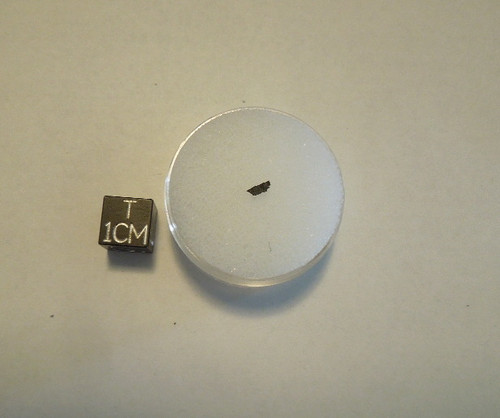The Barnstable meteorite was recovered from under a pile of leaf litter surrounded by a cluster of blueberry bushes in rural part of Massachusetts in August of 2018. Further searching revealed a few more small pieces in the vicinity of the initial find. Pieces were analyzed at UCLA and classified as an H4 chondrite with a shock stage of S1 and a weathering grade of W5. Visually, it is a dark brownish stone with scattered chondrules. It is one of only two meteorites ever found in Massachusetts.
Refer to the photo. The black centimeter cube is shown for scale and is not included. You are purchasing a single small fragment similar to the one shown. Your purchase will include a labeled gemjar for safe storage.
From the Meteoritical Bulletin entry on Barnstable :
Barnstable 41.6969048°N, -70.3911813°W
Massachusetts, United States
Find: 2018 Aug 18
Classification: Ordinary chondrite (H4)
History: The main mass was found on the surface resting in decomposing leaves surrounded with wild native blueberry bushes; other fragments were found similarly, covered with leaves with margins encased in soil, and some were found beneath the surface 1-4" deep. The first 1113 g fragment was found on August 18, 2018, and the main mass was discovered on September 11, 2018; remaining fragments were found between those date through 2018. All fragments were found in close proximity, in an area approximately 25’ × 5’, with smallest fragments toward one end.
Physical characteristics: Specimen has a smooth surface with shallow regmaglypts. The main mass is 28 × 20.5 × 13 cm in size and appears oriented (shield orientation), with frothy roll over lip on one side. Some fragments have bits of remnant fusion crust, others show secondary fusion crust. White chondrules visible on most broken surfaces.
Petrography: In addition to olivine and low-Ca pyroxene, there is minor Ca pyroxene (Fs6.9±0.7Wo44.2±0.7; n = 2) and plagioclcase (Ab83.1±0.7Or5.7±0.6; n = 6). Olivine and low-Ca pyroxene are homogeneous. Very few low-Ca pyroxene grains exhibit polysynthetic twinning. Chondrules are readily discernable and include the following textural types: BO, RP, PO, PP, POP, GOP. Only about 10-15% of the olivine grains show undulose extinction. There are no planar fractures. There are no coarse metal grains. All of the metallic Fe-Ni has been altered to limonite/goethite. There are a few feathered troilite grains remaining; also present are minor patches of clay minerals at the boundaries of mafic silicate grains. There is moderate silicate darkening in the specimen due to the presence of thin silicate-opaque veinlets. Also occurring are 30-40-µm-size chromite-plagioclase assemblages with 2-5-µm-size chromite grains. There are also small chromite veinlets containing plagiolcase patches within some olivine grains. The rock appears to have been shocked and annealed.





